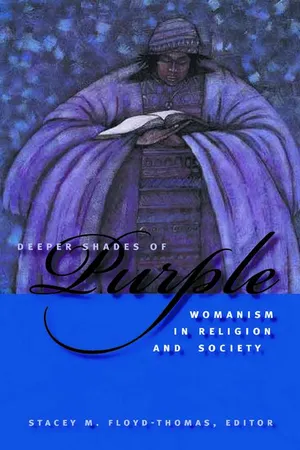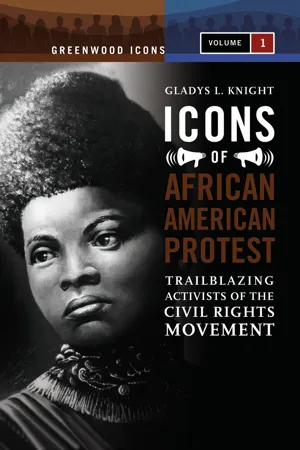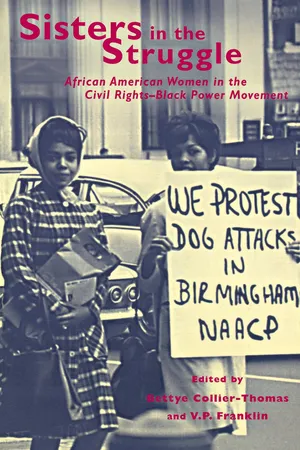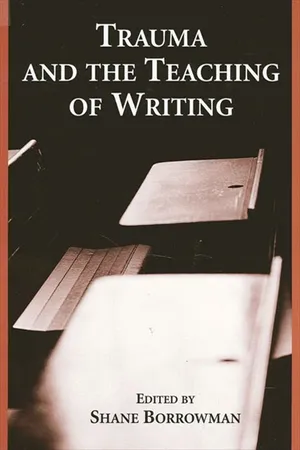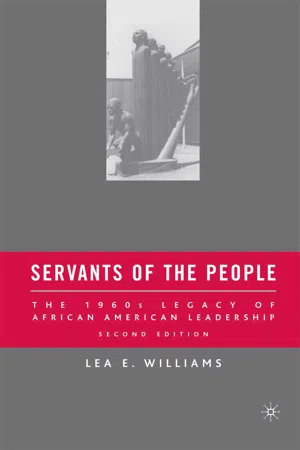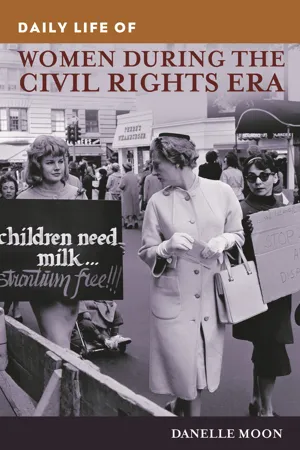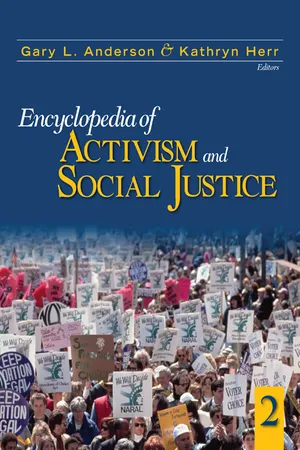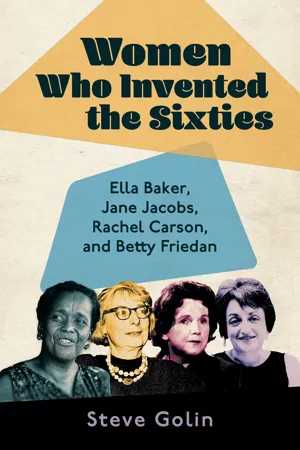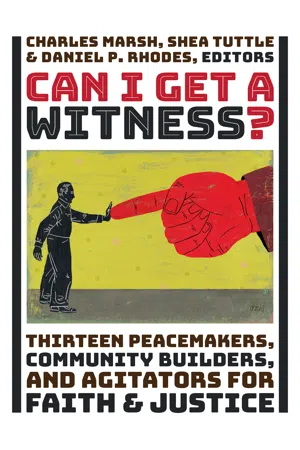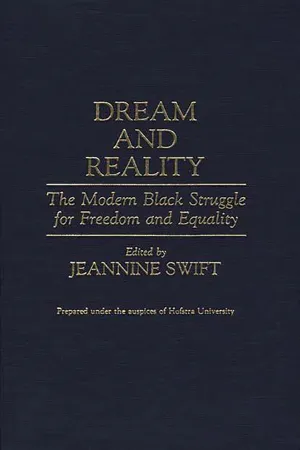History
Ella Baker
Ella Baker was a prominent African American civil rights activist and leader. She played a key role in the civil rights movement, working alongside prominent figures such as Martin Luther King Jr. and W.E.B. Du Bois. Baker was known for her grassroots approach to organizing and empowering local communities, and she was a driving force behind the formation of the Student Nonviolent Coordinating Committee (SNCC).
Written by Perlego with AI-assistance
Related key terms
1 of 5
12 Key excerpts on "Ella Baker"
- eBook - ePub
Deeper Shades of Purple
Womanism in Religion and Society
- Stacey M. Floyd-Thomas(Author)
- 2006(Publication Date)
- NYU Press(Publisher)
14 allows them to fashion a religiosity that carries on while expanding the tradition from which they emerged. Another example is evident in the life and work of Ella Baker: focused social activism. Born in 1903 in Norfolk, Virginia, Ella Baker has become known as one of the persons who helped conceptualize, shape, and carry on the Civil Rights movement. Baker attended and graduated from Shaw University in Raleigh, North Carolina, in the 1920s. After graduation, Baker decided against the anticipated profession of schoolteacher, and instead moved to New York where she took odd jobs while developing a career for herself in community work. During the 1930s, Baker was an active officer of the Young Negroes’ Cooperative League which sought to improve the lives of Depression era black persons through co-op buying. From around 1940 to 1946, she served as a field secretary and later as director of branches for the national NAACP. After leaving NAACP employment, she worked with the Urban League and a local New York NAACP branch. Because Baker began her lifelong vocation of community organizing as early as the late 1920s, she was not only deeply familiar with evolving social and political developments in the country, but she also was insightful enough to recognize and to take full advantage of the potential of the time during which she lived. This is how she came to help shape the Civil Rights movement.From New York, Ella Baker supported the Montgomery Bus Boycott through fundraising efforts. Later she helped initiate organization of the Southern Christian Leadership Conference (SCLC) to capitalize on the boycott’s social gains after it ended. In 1957, Baker moved south to Atlanta and developed the administrative and programmatic infrastructure of the newly formed SCLC, becoming its de facto first executive director, though her gender and her status as a lay person prevented Baker’s ever formally holding the title. As her work with the SCLC was ending, Baker helped organize student leaders of sit-ins and, seeing great potential in the young people’s energy and enthusiasm, Baker encouraged students to form their own organization. This resulted in emergence of the Student Non-Violent Coordinating Committee (SNCC). Over the course of her career Baker emphasized empowering people. She once said, “Give people the light and they will find a way.”15 - eBook - PDF
Icons of African American Protest
Trailblazing Activists of the Civil Rights Movement [2 volumes]
- Gladys L. Knight(Author)
- 2008(Publication Date)
- Greenwood(Publisher)
Ella Baker (1903–1986) Library of Congress Ella Baker worked in a variety of positions in several of the prominent civil rights organizations: the National Association for the Advancement of Col- ored People (NAACP), the Southern Christian Leadership Conference (SCLC), and the Student Nonviolent Coordinating Committee (SNCC). Indeed, she was instrumental in the founding of SNCC and remained for several years an indispensable advisor. By all accounts, her work with SNCC, in the early to mid-1960s, when the organization strived towards integrating society and pushing voter registration in black communities, was her pride and joy. Most everyone knew the slight, 5 0 2 00 woman as ‘‘Miss Ella.’’ She was the one who sat quietly in a corner at the SNCC meetings. She was the oldest of them all, with graying hair, wearing a matronly dress with matching ear- rings. When things got heated—as they normally did in a room filled with the mostly twenty-something activists—she had a calming effect. All it took was a word or a question to redirect the passionate argument back to a pro- ductive discussion. This sagacious woman did not try to impose her point of view, gained from years of experience as an activist, on the youths; rather, she gently and unobtrusively helped develop and equip them for their im- portant work. Later, when the organization became more militant, casting out all its white members and adopting an ideology of separatism, Baker graciously bowed out. Baker was disappointed in this turn of events, but she still had work to do, work that she approached in the same quiet and inconspicuous way she had always used. She was never really a one-organization kind of woman; she always had a rally to go to or a committee meeting to attend. But what- ever she engaged in, she did so out of the limelight—unlike so many of the highly visible personalities of her day. Martin Luther King, Jr. was one of the most famous civil rights leaders. - eBook - ePub
North Carolina Women
Their Lives and Times
- Michele Gillespie, Sally McMillen(Authors)
- 2015(Publication Date)
- University of Georgia Press(Publisher)
SNCC , arguably the most radical civil rights organization in the early 1960s, is the achievement for which Baker is often remembered. It was through this organization that her philosophy was most clearly formulated and expressed.Baker, and almost every other person who fought for civil rights in the 1950s and 1960s, has become a part of a pantheon of great Americans who have been pinned to a neatly ordered narrative that begins in 1954 with the Brown v. Board of Education Supreme Court decision and ends with the 1965 Voting Rights Act. These short but strident years of the civil rights movement have been the subject of much debate in recent years. Many historians have called for a more expansive understanding of the movement and have advocated an extended framework, the “long civil rights movement.”4 This new framework roots the political, social, and temporal origins of the civil rights movement in the 1930s rather than in post–World War II America and illustrates the fundamental place of economic justice alongside political and social equality in the movement. Ella Baker’s life illuminates the binding ties between the radicalism of the 1930s and the “classical phase” of the movement two decades later. Her work is testament to the ways in which the democratic ideals cultivated in the Great Depression fundamentally shaped the discourse and desires of the American civil rights movement.ELLA JOSEPHINE BAKER Baker called the 1960 meeting of student activists in Raleigh, North Carolina, that created the Student Non-Violent Coordinating Committee. Photo by Danny Lyon, Magnum Photos.Ella Josephine Baker was born on December 13, 1903, in Norfolk, Virginia, to Georgianna (Anna) and Blake Baker. She was the middle of three surviving children, with an older sister and a younger brother. Baker’s parents were born and raised in eastern North Carolina. Her father’s parents were tenant farmers from the small town of Warrenton, North Carolina; her mother’s family came from the nearby riverside community of Elam, near Littleton. Blake Baker and Anna Ross married in North Carolina in 1896, the same year that the U.S. Supreme Court upheld Jim Crow laws by a 7–1 vote in Plessy v. Ferguson . The newlyweds, like tens of thousands of blacks in the post-Reconstruction South, faced limited opportunities in rural communities of old plantations and newer tenant farms. In 1900, three years before Ella’s birth, the Bakers moved to the port city of Norfolk. Blake and Anna Baker’s migration from the farmlands of North Carolina to the city was part of a larger exodus of African Americans from the southern countryside at the turn of the century. In Norfolk alone the labor force increased fivefold between 1880 and 1900.5 - eBook - ePub
Sisters in the Struggle
African American Women in the Civil Rights-Black Power Movement
- Bettye Collier-Thomas, V.P. Franklin(Authors)
- 2001(Publication Date)
- NYU Press(Publisher)
In addition to the lessons Ella Baker conveyed and the example she set, she also provided SNCC activists with a strong connection to history. A common myth about the Civil Rights Movement, especially the Black Power phase of the movement, is that these periods of intense political protest simply erupted on the national scene with little connection to early periods of struggle. But while the intensity and widely publicized character of the protests may have represented a departure from the past, the spirit of determined resistance did not. Ella Baker often railed against the stereotype that black southerners were passive and complacent before 1955. And if any single life or political career belied this myth, it was hers.Ella Baker fought on the front lines of the Black Freedom Movement in the United States for over a half century. After her arrival in Harlem in the late 1920s, she immersed herself in the radical political activities there. She condemned Italy’s invasion of Ethiopia. She protested the unfair treatment of black domestic workers during the Depression. And she helped launch the Young Negroes Cooperative League to ameliorate the suffering of the poor and explore socialist alternatives to capitalism. During World War II she joined forces with the National Association for the Advancement of Colored People, and traveled throughout the South recruiting new members. She raised funds for the Montgomery Bus Boycott and left her home in New York City to move to Atlanta, where she served as the first staff person of the coalition that emerged out of it, the Southern Christian Leadership Conference. Most notably, in 1960 Ella Baker was instrumental in the formation of the Student Nonviolent Coordinating Committee, an organization that would become a pivotal and catalytic force within the growing liberation movement.Ella Baker was an advisor, a teacher, and a confidante to many young people who came of age politically in the 1960s. But she knew much more about their lives than they knew about hers. In the words of SNCC leader and Baker protege Robert Moses, “We didn’t know much about Ella’s life before SNCC … (but) she brought (that) history with her.”5 - eBook - PDF
- Shane Borrowman(Author)
- 2012(Publication Date)
- SUNY Press(Publisher)
MILLER AND KATHLEEN WEINKAUF 114 energetic and outspoken activist with a public profile large enough to intimi- date President Lyndon Johnson (Lee, Marsh, Payne, Reed). Amelia Boynton played a crucial role in spawning the 1965 voting rights protests in Selma, Alabama, and was beaten and tear-gassed by police (Garrow, Protest; Olson). Even before Paolo Freire began his career in Brazil, other women, most notably Septima Clark, spearheaded Freire-like politicized literacy efforts as an important component of movement organizing in numerous states (Clark). Unarguably, Ella Baker was one of the most important figures of the entire civil rights movement. Working quietly, she recruited people to join the NAACP in the 1940s. Impressed with her courageous voyages to the Deep South and her relentless devotion to the cause, the NAACP promoted her to national director of its branches in 1943, a position she held until her resig- nation in 1946. In 1957 Baker, Stanley Levison, and Bayard Rustin founded the Southern Christian Leadership Conference (SCLC), which King headed. Baker remained a central figure in SCLC in 1958 and 1959, attempting, with few resources, to organize King’s band of Baptist ministers—all of whom, fol- lowing the pattern of their national church, were men. In 1960, disgusted with the paternalism, sexism, and inefficiency of King and his clergy, Baker resigned her SCLC post (Ransby, Grant). 1 Baker decided that the ultimate hope for the movement lay with student activists. At a crucial 1960 meeting in Greensboro, North Carolina, she helped create the Student Nonviolent Coordinating Committee (SNCC), a grassroots organization of eager, young dissenters. King firmly suggested that the youths join SCLC and follow his leadership, but Baker urged them to secure autonomy from the “fathering” body. SNCC members agreed with Baker and refused to become a lower part of the SCLC hierarchy (Grant; Carson; Branch; Garrow, Bearing). - eBook - PDF
Servants of the People
The 1960s Legacy of African American Leadership
- L. Williams(Author)
- 2016(Publication Date)
- Palgrave Macmillan(Publisher)
In egalitarian, no-holds-barred forums, Baker rejected the foolhardy notion that a leader had to have all the answers. This was both burdensome and unre- alistic. Instead of imparting knowledge, she preferred troubling the waters and seeing what erupted. In these facilitated dialogues, Ella Baker listened intently while others did the talking. She interrupted to pose a question when the conversations stalled or when conventional orthodoxies and quickly formed conclusions threatened to overshadow the penetrating and critical dissection of issues. By example, Baker taught her protégés and neophytes that viewing situations through diverse frames of reference stimulated creative, dynamic thinking, which could lead to innovative solutions to problems. S E R V A N T S O F T H E P E O P L E 168 CHALLENGING THE STATUS QUO By the ’60s, idealistic young civil rights activists were drawn to Ella Baker, a mature woman of their mother’s generation. Baker had a gift for seeing the potential in others, and a commitment to nurturing those seeds. As a shrewd and swift judge of character, she acted decisively in recruiting highly intelligent and energetic youth volunteers and exposed them to movement elders in order to boost their self-confidence, demystify the aura of power, and minimize the tendency toward hero worship. With Ella Baker’s guid- ance and prodding, these neophytes learned to think strategically and exer- cise sound judgment in organizing communities under difficult and perilous circumstances. The premier organization for harnessing and channeling the activism of college students during the civil rights era was the Student Nonviolent Coordinating Committee. - eBook - ePub
Ella Baker's Catalytic Leadership
A Primer on Community Engagement and Communication for Social Justice
- Patricia S. Parker(Author)
- 2020(Publication Date)
- University of California Press(Publisher)
Ella Baker understood that that kind of knowledge is found in subaltern spaces: in the silences, paradoxes, resistance to, and decision to take action that emerge from those with their necks under the heels of power and injustice (Ransby, 2003). She first began working out the specifics of that perspective in the 1930s, when she immersed herself in and was an influencer on what she later described as “a hotbed of radical thinking” in Harlem (Cantarow, 1980, p. 64). Writing and engaging in intellectual debates, she helped forge the rapidly developing cooperative movement for economic empowerment during the worst years of the Great Depression. In the 1940s, working as the NAACP director of branches, she applied that knowledge, laying the groundwork for the coming Black freedom movements in the South by reframing the ways local branches engaged with national organizations. For example, instead of engaging in the normal practice of simply asking members of local branches to pay dues and receive dignitaries, Baker trained local people to become leaders. She organized and taught a series of workshops in which she honed her group-centered leadership approach. And she arranged for people to collect their stories of resistance to help fuel the movement. Their everyday acts of resistance and martyrdom in the Jim Crow South had been part of a quiet, hidden struggle for survival—one that suddenly found new meaning as fuel for a growing national freedom movement. Ella Baker’s efforts to reframe community members’ experiences as essential to a growing national freedom movement was also a form of amplification and extension. Local resistance to violence against Black bodies and the fight for voting rights, which were already well under way in certain circles, intensified as the cause du jour. These efforts were rearticulated and extended to new recruits through local grassroots leadership within local NAACP branches - Danelle Moon(Author)
- 2011(Publication Date)
- Greenwood(Publisher)
Despite the role of women, civil rights and social movement leadership was dominated by the public male personalities. In the NAACP and the Southern Christian Leadership Conference (SCLC), men dominated as decision makers and dealt with the media and political sphere, while women typically played secondary roles as unofficial leaders providing the backbone of com- munity and grassroots organizing. The male leaders marginalized women and in many cases relegated them to secretarial roles or as workers on education-based projects—this was particularly true in the SCLC and in the Student Nonviolent Coordinating Commit- tee (SNCC). Gender stereotypes played an important part in social movement hierarchies, despite the number of very qualified women. Many women felt frustrated by the gendered boundaries within spe- cific civil-rights-based groups, and for some, the sexism they faced inspired them to become active in the modern feminist movement. 4 BRIDGE LEADERSHIP AND Ella Baker (1903–1986) Ella Baker is a primary example of a female bridge leader. Baker grew up in the South and was firmly minted in social reform ac- tivism as a young child. Her grandfather, a former slave and Civil Rights 135 Reconstruction-Era activist, and her mother, a well-known public speaker and active member in the local church and missionary so- ciety, served as her role models. Baker excelled in school, becoming the valedictorian of the 1922 class at the historically black Shaw University. She had hoped to go to graduate school, but her fam- ily lacked the financial means to support her. She left the South for New York, hoping to find stimulating work, but at that time, em- ployment opportunities for black women were limited to domestic service, factory work, or teaching. Baker’s interests were not met in these areas, but she found the city a stimulating environment for radical new thinking.- eBook - PDF
- Gary L. Anderson, Kathryn G. Herr, Gary Anderson, Kathryn G. Herr(Authors)
- 2007(Publication Date)
- SAGE Publications, Inc(Publisher)
Baker returned to Harlem and was elected president of the New York City NAACP branch. By building coalitions, she organized campaigns on issues such as desegregation, school reform, and police brutality. Her involvement in coalition politics resulted in her unsuccessful run for elective office for the New York City Council on the Liberal Party ticket. In 1956, Baker, along with Stanley Levison and Bayard Rustin (both men would become advisors to Martin Luther King, Jr.), founded In Friendship, an organization that raised funds to aid the growing civil rights struggle in the South, including the Montgomery Improvement Association, the coordinator of the Montgomery bus boycott. In 1957, Baker and Rustin went south to help organize the founding meeting of the Southern Christian Leadership Conference Baker, Ella (1903–1986) ——— 213 (SCLC). As in her earlier work in the NAACP, Baker played an important if largely unacknowledged role in the SCLC. Her criticism of its reliance on charismatic male leaders and hierarchical organizational structures would cause tension with the SCLC leadership, includ-ing Martin Luther King, Jr. She was instrumental in organizing the successful May 17, 1957, Prayer Pilgrimage for Freedom held at the Lincoln Memorial in Washington, D.C. Attended by 25,000 to 30,000 people, it provided a national political stage for the SCLC. In 1958, Baker moved to Atlanta and worked for the SCLC directing the voter rights campaign, Crusade for Citizenship. Baker continued to urge SCLC leaders to promote mass action programs, to target women’s involvement, and to develop youth and action work. In April 1960, following a series of student deseg-regation sit-ins, Baker invited students and other lead-ers to a conference at Shaw University, her alma mater. Later that year, she helped them form the Student Nonviolent Coordinating Committee. - eBook - PDF
Women Who Invented the Sixties
Ella Baker, Jane Jacobs, Rachel Carson, and Betty Friedan
- Steve Golin(Author)
- 2022(Publication Date)
- University Press of Mississippi(Publisher)
Part 1 The Fifties 3 1 Ella Baker: Activists’ Activist Ella Baker, 1962, photograph by Danny Lyon. Courtesy of Ella Baker Center for Human Rights. A Radical Sense of Equality Ella Baker probably knew more about building movements from below than anyone in America. After graduating from college in 1927, in North Carolina, she moved to Harlem, where she learned from intellectuals who talked class struggle and from union organizers who practiced it. She combined class with race, looking for seeds of future uprising in all those excluded from power 4 Ella Baker: Activists’ Activist and status: Blacks, workers, women, young people. Her whole approach was based on grass-root struggle and confrontation. She was immediately excited to be in New York, as Jane Jacobs would be eight years later, but not for the same reason. It was not the streets or neigh- borhoods that excited her, but the ideas. “New York was the hotbed of—let’s call it radical thinking. You had every spectrum of radical thinking. . . . We had a lovely time! The ignorant ones, like me, we had lots of opportunity to hear and to evaluate whether or not this was the kind of thing you wanted to get into. Boy, it was good.” 1 As she listened, she decided what to get into. Listening was never passive for her, never opposed to acting. Early on, she waitressed in Greenwich Village, near Washington Square. My first discussion on communism was from a Russian Jew. . . . I would go down in Washington Square Park. I liked to smell the fresh-turned earth, and they used to plow up and plant new grass or flowers or something. And I was just standing there enjoying, I guess indulging my nostalgia for the land. And he began to talk, and I listened. . . . He wasn’t too keen about the Soviets. He was basically approving the concept, but highly critical of the implementation of the concept so far as the Russian Revolution was concerned. 2 In Harlem, she met other anti-Soviet Marxists as well as Marxists who were pro-Soviet. - eBook - ePub
Can I Get a Witness?
Thirteen Peacemakers, Community-Builders, and Agitators for Faith and Justice
- Charles Marsh, Shea Tuttle, Daniel P. Rhodes, Charles Marsh, Shea Tuttle, Daniel P. Rhodes(Authors)
- 2019(Publication Date)
- Eerdmans(Publisher)
28 She refused to permit the student’s efforts, including their leadership during the sit-ins, to become window dressing to the work of the ministerial establishment. When SCLC leaders persisted in their attempt, Baker walked out of the caucus.Her action shook the caucus and the entire movement. “Baker’s departure [from the caucus] signaled the beginning of a new phase for the civil rights movement. It was no longer controlled by a stodgy ministerial or bureaucratic presence. It was to be led by a new force.”29Despite Baker’s anger over the SCLC’s plan, she acted in good faith; she refused to twist arms to make the vote fall her way. Certainly, the SCLC possessed indispensable resources and political access that offered foundation and structure to the movement as a whole. Yet Baker maintained a position that became a hallmark of her Christian witness: there would be no movement without empowering and prioritizing the young people. The relationship between the SCLC and the SNCC remained tense, but the SNCC did continue as a student-led organization.While Baker supported the students in their efforts, she insisted that the movement was about larger issues than lunch counters; it was about “more than a hamburger and a Coke.”30 True freedom required learning to treat others with dignity and equality outside of the realms of economics and politics. It was about teaching others to love freedom and to do the work required to sustain it. Baker considered human equality to be a divine calling, a state that was good for its own sake. And she offered the students another perspective on their organizing without dousing the flames of the passionate pursuit of their own most important issues and campaigns.Baker didn’t just teach the content of freedom to the students; she modeled what was required to live an authentically free life. This authenticity was key to her advocacy. “What was nice about Miss Baker,” according to one SNCC worker, “is you never felt that she had a personal agenda that she was trying to put on. It was always about what is good for the organization, for black people, for whatever the larger issue was. [With] other adults you never really knew what was hidden.”31 - eBook - PDF
Dream and Reality
The Modern Black Struggle for Freedom and Equality
- Jeannine Swift(Author)
- 1991(Publication Date)
- Praeger(Publisher)
The current reexamination and reconstruction of the Civil Rights Movement has revealed several types of new information and provided analyses that were not possible earlier. For example, the Freedom of Information Act, utilized by a number of researchers, enabled them to confirm suspicions about the role of the FBI, our chief executives, and other officials. Also, the movement itself no longer has to preserve certain secrets or picture itself as spontaneous rather than organized. And now, in dialectical fashion, the Women's Movement is acting back on the Civil Rights Movement, as participants and scholars reexaraine the movement from the perspective of gender. Of particular importance are the new autobiographical accounts of such women as Septiraa Clark, Jo An Gibson Robinson, and Mary King. (3) These leading activists are telling their stories of major events as they now perceive and remember them. The movement is called challenging and role-expanding; the women learned skills and contributed ideas but received little national recognition. In the case of Ella Baker, the most influential woman strategist of the movement, recognition as a leader was neither sought nor valued. Septima Clark's autobiography was told to Cynthia Stokes Brown when Clark was eighty-one years old and is a story "told from a feminist perspective." For, "after the Civil Rights Movement, Mrs. Clark too part in the women's liberation movement and learned to comprehend her ow 20 Rhoda Lois Blumberg story, as well as that of women in general, in a framework very different from that through which she experienced her life as it happened."(4) In contrast, Ella Baker was keenly aware of male chauvinism as it occurred.
Index pages curate the most relevant extracts from our library of academic textbooks. They’ve been created using an in-house natural language model (NLM), each adding context and meaning to key research topics.
